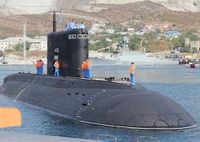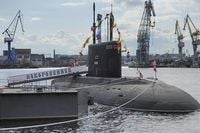On September 27, 2025, reports began to emerge of a serious incident involving the Russian submarine Novorossiysk, a 242-foot Kilo-class vessel belonging to the Black Sea Fleet, while it was on combat duty in the Mediterranean Sea. The incident, first flagged by the Russian Telegram channel VChk-OGPU, quickly drew international attention due to the nature of the submarine’s distress and the potential environmental and security risks involved. According to multiple sources, including the Associated Press and The U.S. Sun, the Novorossiysk was seen surfaced off the coast of Gibraltar, signaling an urgent situation that required the crew to bring the vessel above water.
The heart of the crisis centered on a fuel leak in the submarine’s hold—a leak severe enough to prompt alarms of a “danger of explosion.” According to VChk-OGPU, the fuel system had suffered significant damage, allowing fuel to seep directly into the hold and accumulate to dangerous levels. The situation escalated as the crew realized they lacked both the spare parts and the qualified specialists necessary to attempt repairs at sea. As the fuel continued to pool inside the vessel, the risk of an explosion increased, raising alarms not just for the crew but for naval observers and environmentalists alike.
One chilling detail reported by VChk-OGPU and cited by The U.S. Sun and AP was that the crew might have no choice but to pump the accumulated fuel directly into the Mediterranean Sea. “Novorossiysk, currently on combat duty in the Mediterranean Sea, is experiencing serious technical problems. Due to damage in the fuel system, fuel is leaking directly into the hold. There are no spare parts for repairs or qualified specialists on the submarine, and the crew is unable to fix the malfunctions,” the channel reported. “The serious accident has caused other problems as well. The accumulated fuel in the hold is an explosive hazard. The source believes the crew has no choice but to start ‘pumping out the hold’ directly into the sea.”
This predicament places the crew in a dire bind: to avoid a catastrophic explosion, they may be forced to discharge fuel into the sea—a move that would have significant environmental consequences and could provoke diplomatic tensions, especially given the sensitive location near the Strait of Gibraltar. The Mediterranean, already a region of strategic naval interest, faces the prospect of a hazardous spill from a nuclear-capable submarine.
The Novorossiysk, launched in August 2014, is a diesel-electric attack submarine designed to carry nuclear-capable Kalibr missiles. With a crew of 52 and the ability to remain submerged for up to 45 days, it represents a formidable component of Russia’s Black Sea Fleet. According to The U.S. Sun, the submarine is not believed to have been directly involved in the ongoing war against Ukraine. However, its presence and activities have been closely monitored by Western navies. In fact, the Royal Navy has kept a watchful eye on the Novorossiysk since it appeared in the English Channel in January 2025. In November of the previous year, Defence Secretary John Healey told Parliament that a Royal Navy nuclear submarine was compelled to surface next to the Novorossiysk to ward it off—a rare and dramatic maneuver that underscores the tensions and cat-and-mouse games played beneath the waves.
This incident is not occurring in a vacuum. The Novorossiysk’s sister submarine, Rostov-on-Don, was reportedly sunk by Ukraine in August 2024, a stark reminder of the perilous nature of submarine operations in the region. The Kursk disaster of August 12, 2000, also looms large in the collective memory of the Russian Navy and the international community. The Kursk, an Oscar II class submarine, exploded and sank during a major naval exercise in the Barents Sea, killing all 118 crew members. That tragedy was attributed to a leak of hydrogen peroxide in a torpedo, which triggered a catastrophic chain reaction. The parallels between the Kursk and the current situation with the Novorossiysk—both involving fuel leaks, explosive hazards, and the lack of immediate rescue options—have not gone unnoticed. As The U.S. Sun notes, the current crisis is a “chilling echo” of that earlier disaster.
For the crew of the Novorossiysk, the immediate concern is survival. With no spare parts or technical experts on board, their options are severely limited. The decision to pump fuel into the sea is not made lightly; it is a last resort to prevent a potentially deadly explosion. The environmental implications are significant, as the Mediterranean is a vital and vulnerable marine ecosystem. A fuel spill could affect marine life, local fisheries, and coastal communities, adding another layer of urgency to the situation.
International observers are watching closely. The presence of a Russian nuclear-capable submarine in distress near the Strait of Gibraltar—a chokepoint for global shipping—raises questions about maritime safety, naval readiness, and the protocols for handling such emergencies. The Royal Navy’s previous encounters with the Novorossiysk highlight the ongoing strategic contest between Russia and NATO in European waters. The incident also underscores the challenges faced by aging or overextended military hardware, especially when deployed far from home bases and logistical support.
As of now, Russian authorities have not released official statements detailing the full extent of the damage or the steps being taken to resolve the crisis. The opacity surrounding the incident is not unusual; submarine operations are among the most secretive aspects of modern militaries, and public disclosures are often limited to what cannot be concealed. For now, much of what is known comes from open-source intelligence, naval tracking, and the leaks reported by channels like VChk-OGPU, which has built a reputation for publishing military news and insider information.
For those with long memories, the specter of the Kursk disaster serves as a sobering reminder of the risks inherent in submarine operations. Whether the crew of the Novorossiysk can avert disaster remains to be seen. Their predicament is a stark illustration of the thin line between routine patrols and catastrophe beneath the world’s oceans. As the situation unfolds, the international community waits anxiously for updates, hoping that history does not repeat itself in the depths of the Mediterranean.

